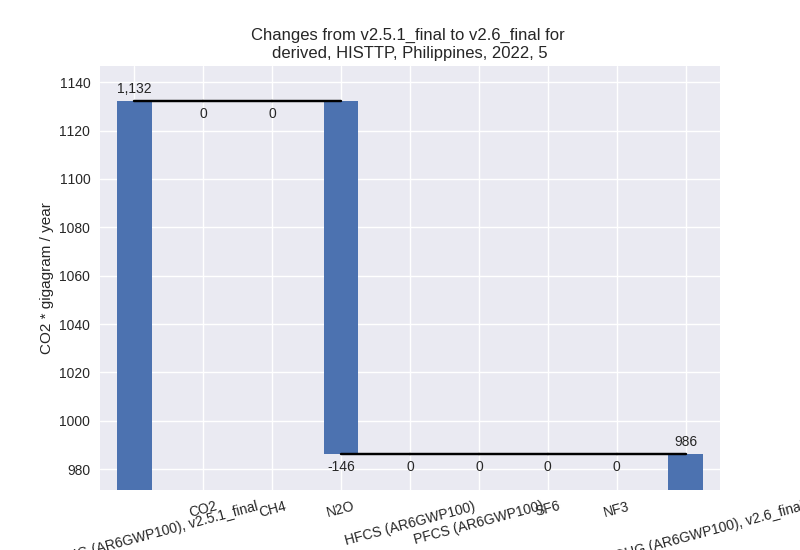Changes in PRIMAP-hist v2.6_final compared to v2.5.1_final for Philippines
2024-09-24
Johannes Gütschow
Change analysis for Philippines for PRIMAP-hist v2.6_final compared to v2.5.1_final
Overview over emissions by sector and gas
The following figures show the aggregate national total emissions excluding LULUCF AR6GWP100 for the country reported priority scenario. The dotted linesshow the v2.5.1_final data.
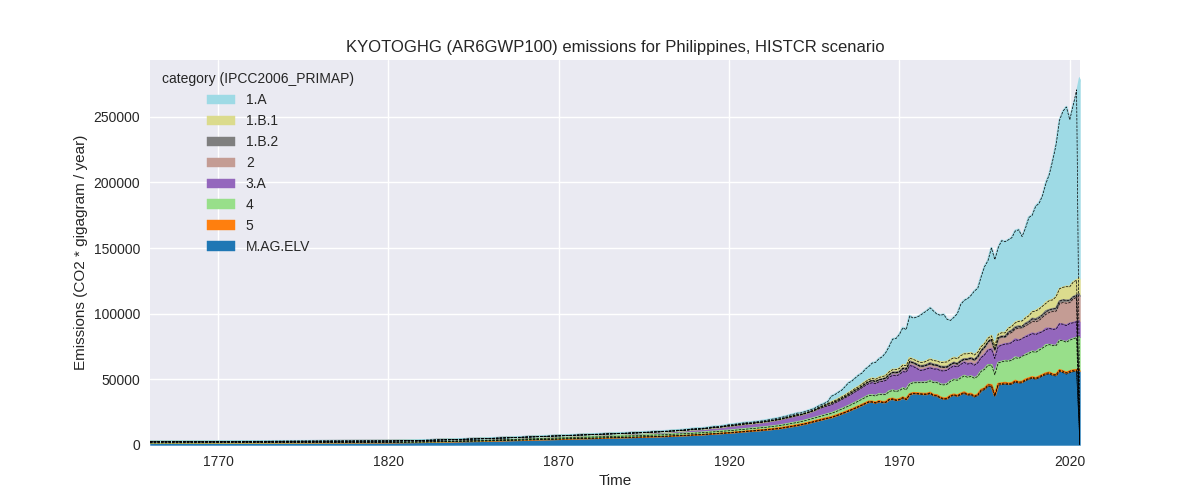
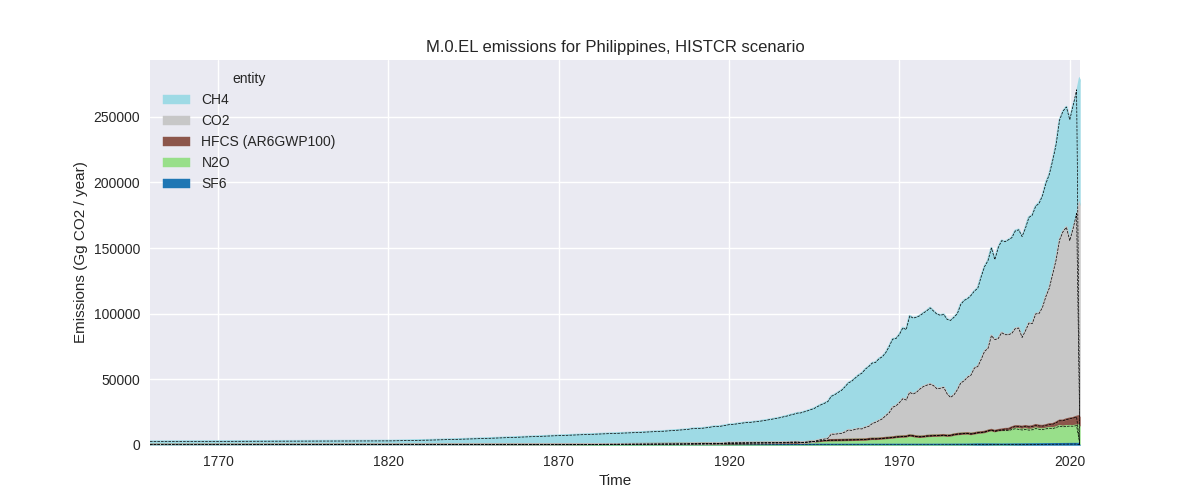
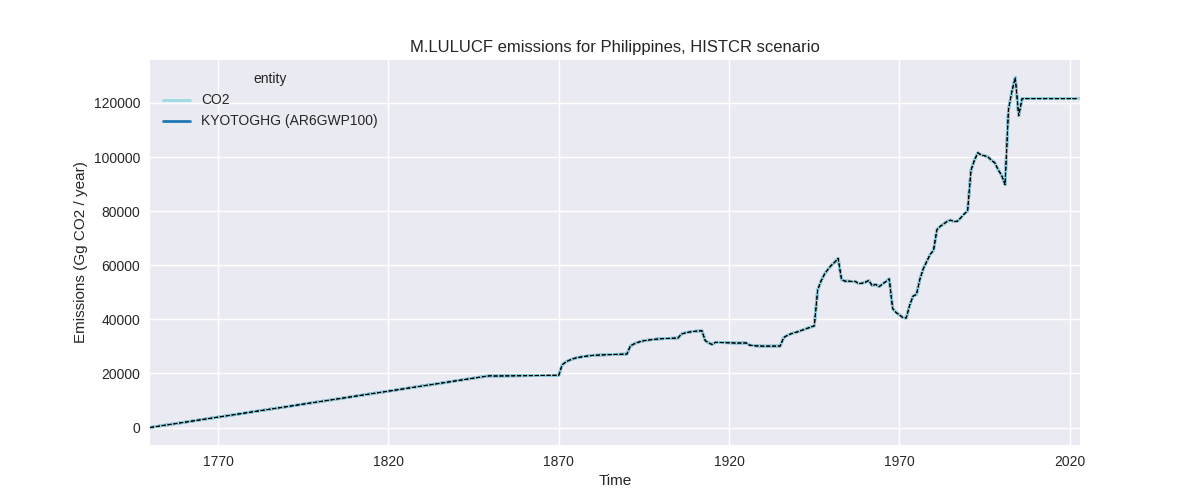
The following figures show the aggregate national total emissions excluding LULUCF AR6GWP100 for the third party priority scenario. The dotted linesshow the v2.5.1_final data.
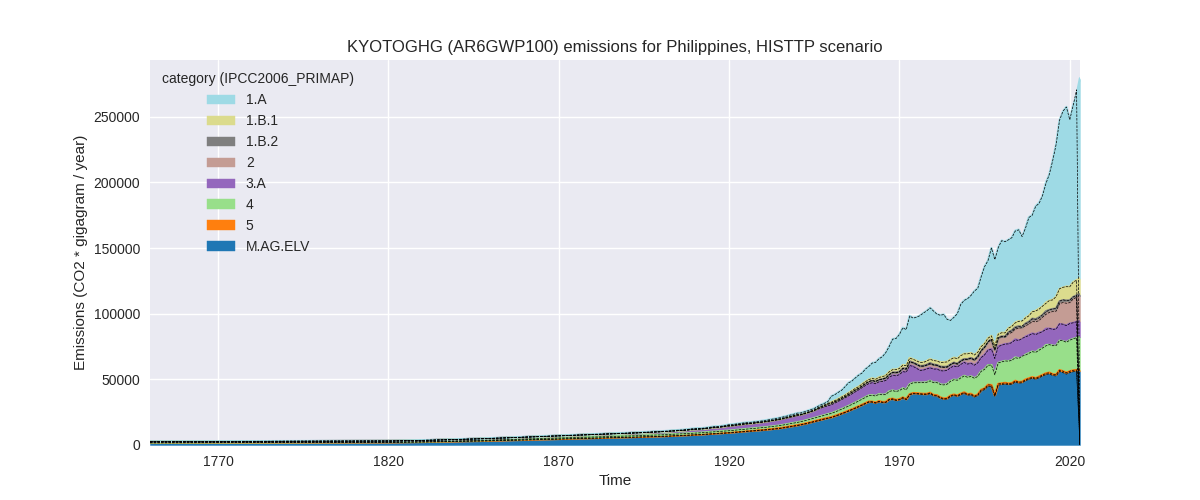
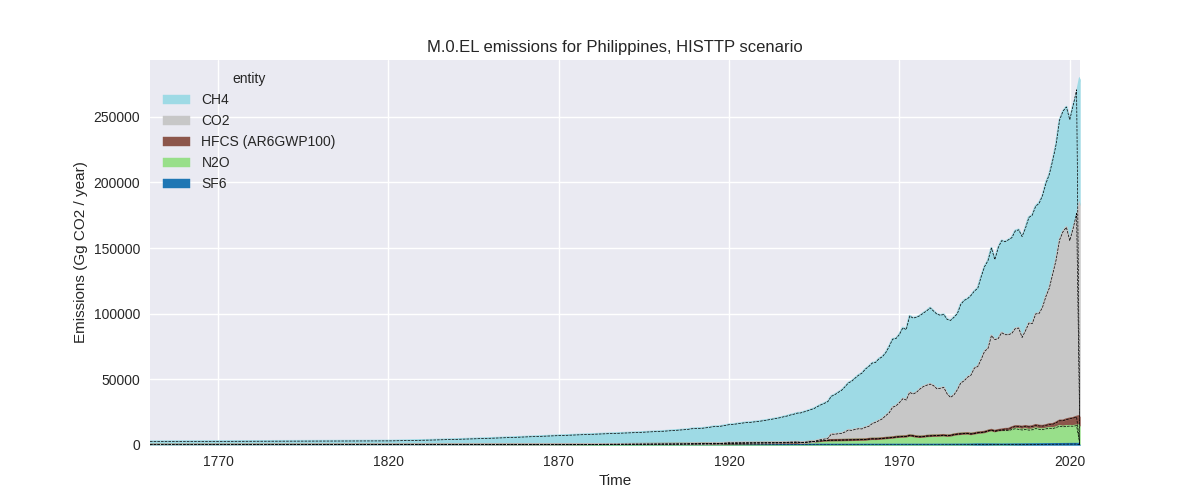
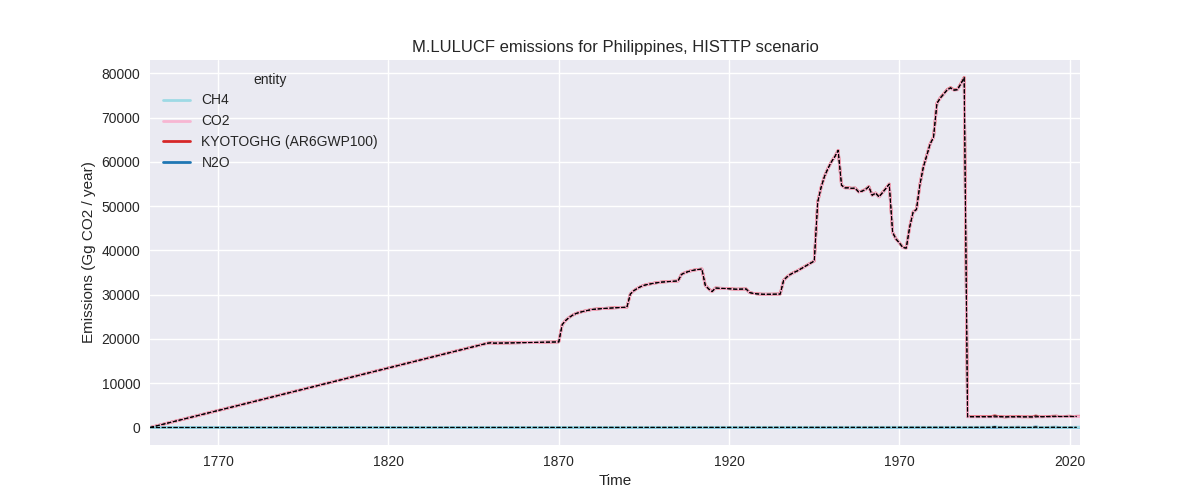
Overview over changes
In the country reported priority scenario we have the following changes for aggregate Kyoto GHG and national total emissions excluding LULUCF (M.0.EL):
- Emissions in 2022 have changed by -1.5%% (-4180.41 Gg CO2 / year)
- Emissions in 1990-2022 have changed by -0.1%% (-181.03 Gg CO2 / year)
In the third party priority scenario we have the following changes for aggregate Kyoto GHG and national total emissions excluding LULUCF (M.0.EL):
- Emissions in 2022 have changed by -1.5%% (-4180.41 Gg CO2 / year)
- Emissions in 1990-2022 have changed by -0.1%% (-181.03 Gg CO2 / year)
Most important changes per scenario and time frame
In the country reported priority scenario the following sector-gas combinations have the highest absolute impact on national total KyotoGHG (AR6GWP100) emissions in 2022 (top 5):
- 1: 1.A, CO2 with -4121.67 Gg CO2 / year (-2.9%)
- 2: 5, N2O with -145.85 Gg CO2 / year (-12.9%)
- 3: 4, CH4 with -130.60 Gg CO2 / year (-0.6%)
- 4: 2, HFCS (AR6GWP100) with 96.61 Gg CO2 / year (1.5%)
- 5: 4, N2O with 92.27 Gg CO2 / year (7.4%)
In the country reported priority scenario the following sector-gas combinations have the highest absolute impact on national total KyotoGHG (AR6GWP100) emissions in 1990-2022 (top 5):
- 1: 1.A, CO2 with -126.70 Gg CO2 / year (-0.2%)
- 2: 4, CH4 with -85.67 Gg CO2 / year (-0.5%)
- 3: 4, N2O with 17.32 Gg CO2 / year (2.0%)
- 4: 5, N2O with -5.00 Gg CO2 / year (-0.6%)
- 5: 2, HFCS (AR6GWP100) with 2.93 Gg CO2 / year (0.1%)
In the third party priority scenario the following sector-gas combinations have the highest absolute impact on national total KyotoGHG (AR6GWP100) emissions in 2022 (top 5):
- 1: 1.A, CO2 with -4121.67 Gg CO2 / year (-2.9%)
- 2: 5, N2O with -145.85 Gg CO2 / year (-12.9%)
- 3: 4, CH4 with -130.60 Gg CO2 / year (-0.6%)
- 4: 2, HFCS (AR6GWP100) with 96.61 Gg CO2 / year (1.5%)
- 5: 4, N2O with 92.27 Gg CO2 / year (7.4%)
In the third party priority scenario the following sector-gas combinations have the highest absolute impact on national total KyotoGHG (AR6GWP100) emissions in 1990-2022 (top 5):
- 1: 1.A, CO2 with -126.70 Gg CO2 / year (-0.2%)
- 2: 4, CH4 with -85.67 Gg CO2 / year (-0.5%)
- 3: 4, N2O with 17.32 Gg CO2 / year (2.0%)
- 4: 5, N2O with -5.00 Gg CO2 / year (-0.6%)
- 5: 2, HFCS (AR6GWP100) with 2.93 Gg CO2 / year (0.1%)
Notes on data changes
Here we list notes explaining important emissions changes for the country. ’' means that the following text only applies to the TP time series, while means that it only applies to the CR scenario. Otherwise the note applies to both scenarios.
- We have no country reported data for the Philippines.
- The only noteworthy change is a reduction in energy CO2 for 2022
- CR and TP scenarios are identical.
Changes by sector and gas
For each scenario and time frame the changes are displayed for all individual sectors and all individual gases. In the sector plot we use aggregate Kyoto GHGs in AR6GWP100. In the gas plot we usenational total emissions without LULUCF. ## country reported scenario
2022
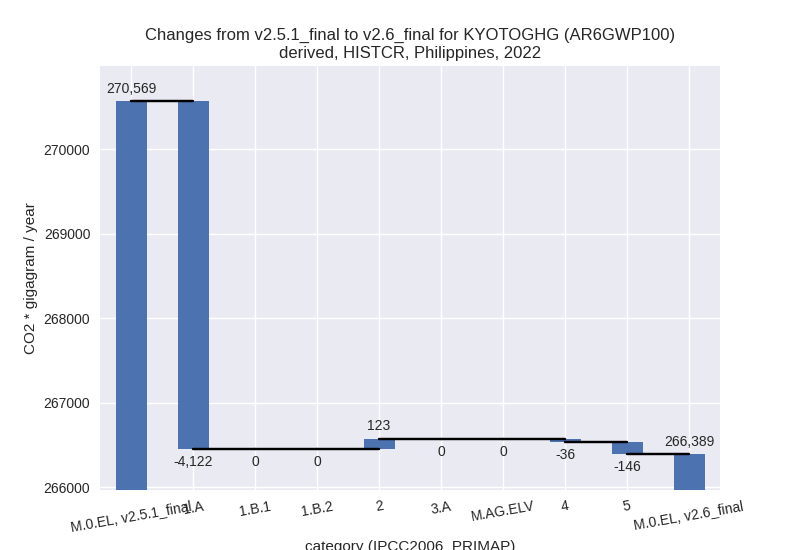
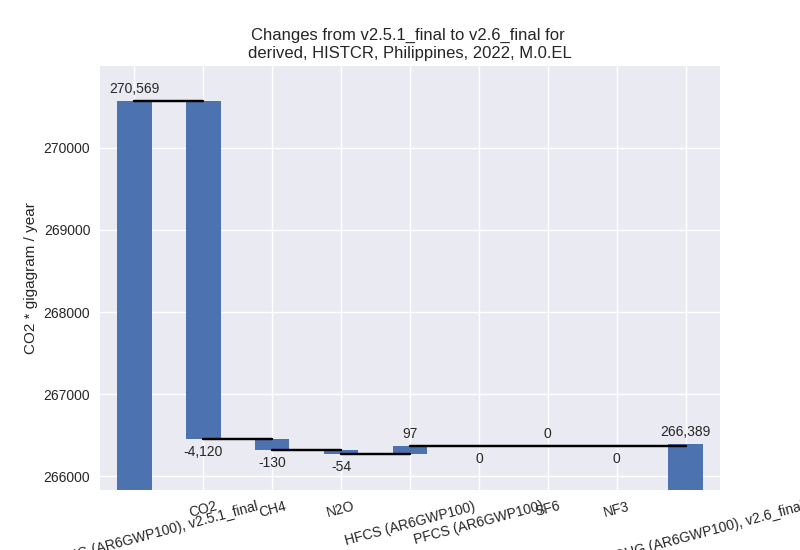
1990-2022
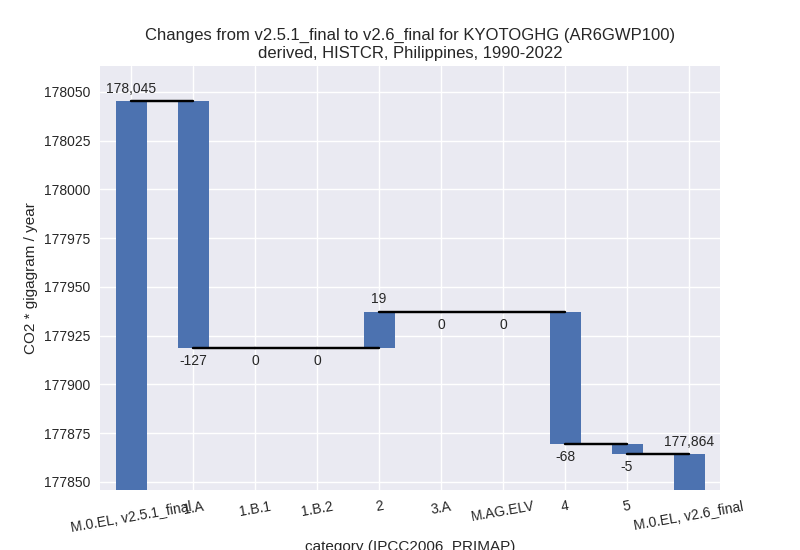
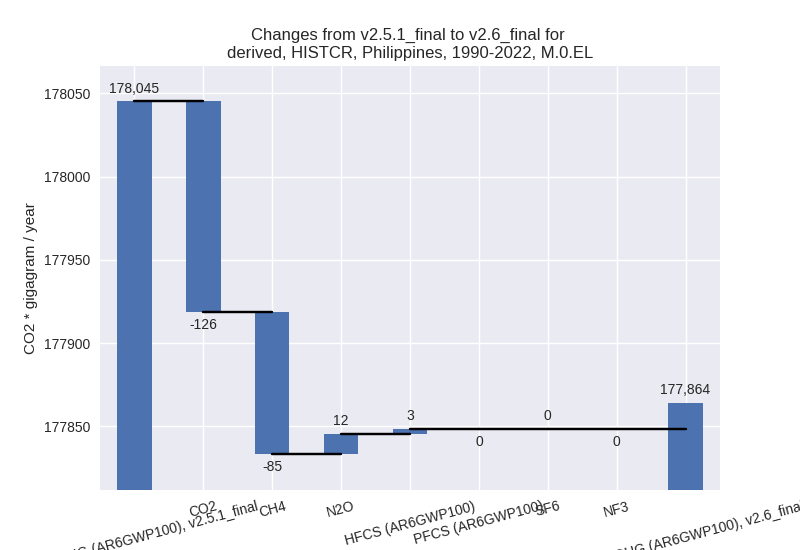
third party scenario
2022
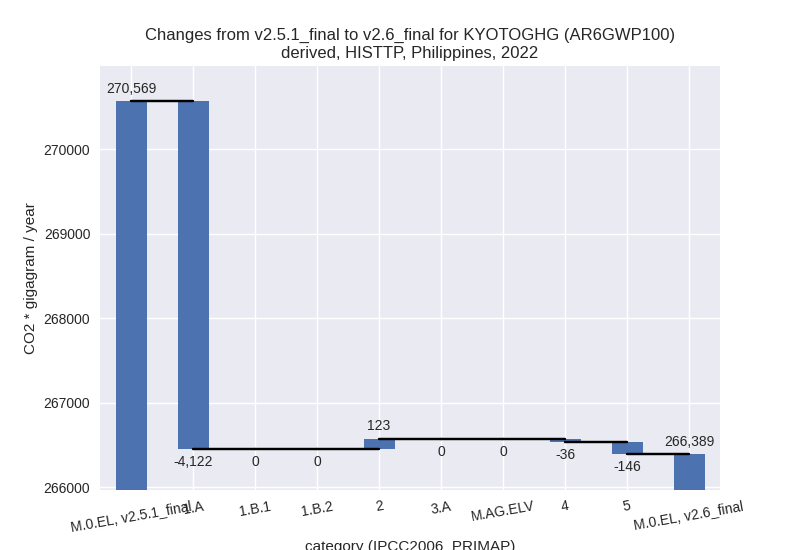
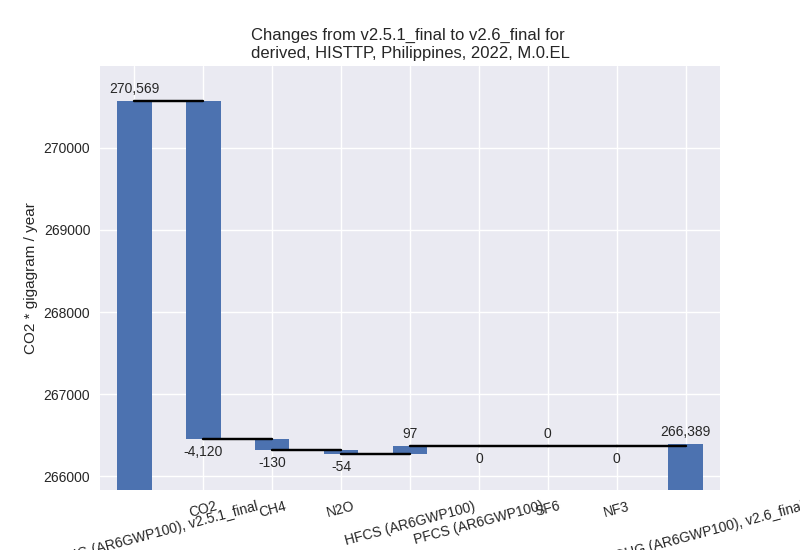
1990-2022

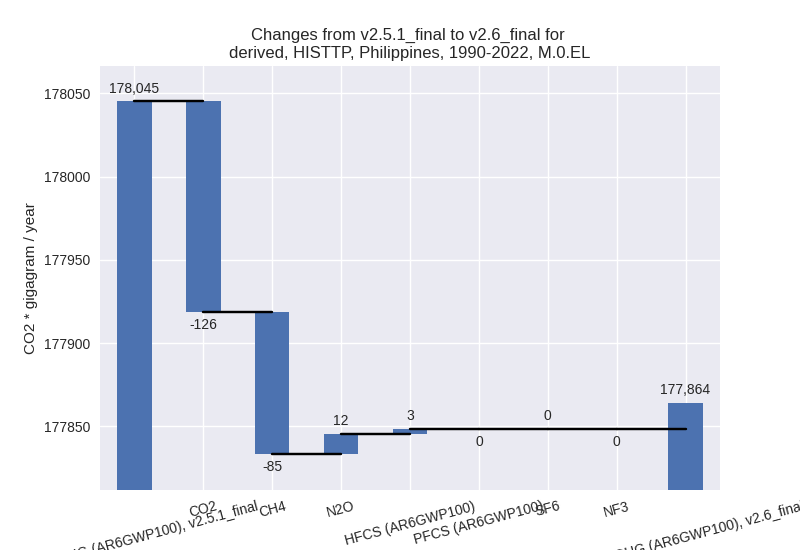
Detailed changes for the scenarios:
country reported scenario (HISTCR):
Most important changes per time frame
For 2022 the following sector-gas combinations have the highest absolute impact on national total KyotoGHG (AR6GWP100) emissions in 2022 (top 5):
- 1: 1.A, CO2 with -4121.67 Gg CO2 / year (-2.9%)
- 2: 5, N2O with -145.85 Gg CO2 / year (-12.9%)
- 3: 4, CH4 with -130.60 Gg CO2 / year (-0.6%)
- 4: 2, HFCS (AR6GWP100) with 96.61 Gg CO2 / year (1.5%)
- 5: 4, N2O with 92.27 Gg CO2 / year (7.4%)
For 1990-2022 the following sector-gas combinations have the highest absolute impact on national total KyotoGHG (AR6GWP100) emissions in 1990-2022 (top 5):
- 1: 1.A, CO2 with -126.70 Gg CO2 / year (-0.2%)
- 2: 4, CH4 with -85.67 Gg CO2 / year (-0.5%)
- 3: 4, N2O with 17.32 Gg CO2 / year (2.0%)
- 4: 5, N2O with -5.00 Gg CO2 / year (-0.6%)
- 5: 2, HFCS (AR6GWP100) with 2.93 Gg CO2 / year (0.1%)
Changes in the main sectors for aggregate KyotoGHG (AR6GWP100) are
- 1: Total sectoral emissions in 2022 are 154002.16
Gg CO2 / year which is 57.8% of M.0.EL emissions. 2022 Emissions have
changed by -2.6% (-4121.67 Gg CO2 /
year). 1990-2022 Emissions have changed by -0.1% (-126.70 Gg CO2 / year). For 2022
the changes per gas
are:
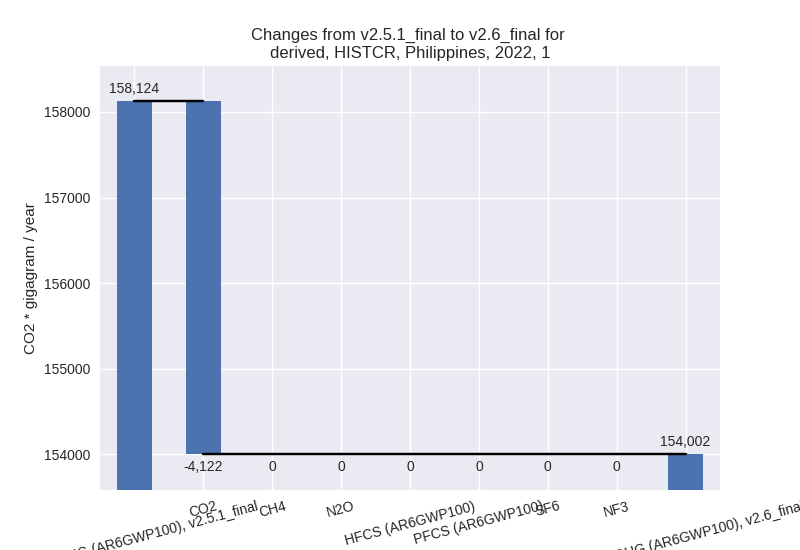
The changes come from the following subsectors:- 1.A: Total sectoral emissions in 2022 are 140892.94
Gg CO2 / year which is 91.5% of category 1 emissions. 2022 Emissions
have changed by -2.8% (-4121.67 Gg
CO2 / year). 1990-2022 Emissions have changed by -0.2% (-126.70 Gg CO2 / year). For 2022
the changes per gas
are:
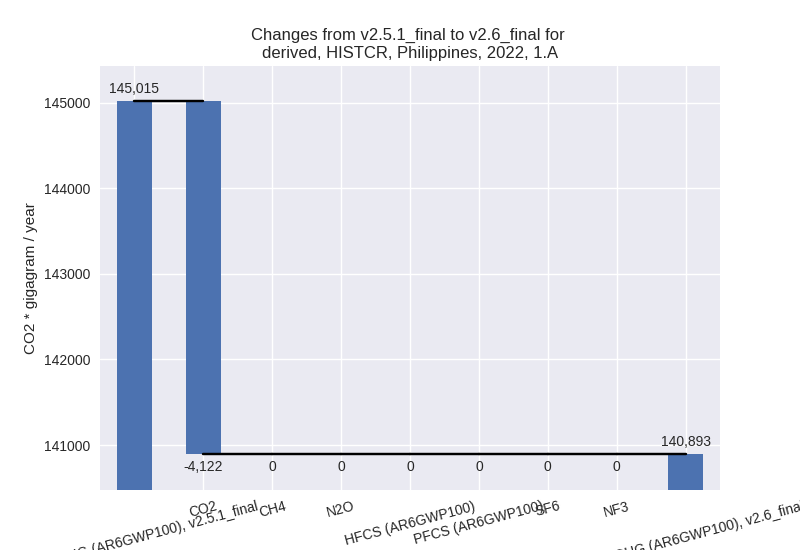
There is no subsector information available in PRIMAP-hist. - 1.B.1: Total sectoral emissions in 2022 are 11615.78 Gg CO2 / year which is 7.5% of category 1 emissions. 2022 Emissions have changed by 0.0% (0.00 Gg CO2 / year). 1990-2022 Emissions have changed by 0.0% (0.00 Gg CO2 / year).
- 1.B.2: Total sectoral emissions in 2022 are 1493.44 Gg CO2 / year which is 1.0% of category 1 emissions. 2022 Emissions have changed by 0.0% (0.00 Gg CO2 / year). 1990-2022 Emissions have changed by 0.0% (0.00 Gg CO2 / year).
- 1.A: Total sectoral emissions in 2022 are 140892.94
Gg CO2 / year which is 91.5% of category 1 emissions. 2022 Emissions
have changed by -2.8% (-4121.67 Gg
CO2 / year). 1990-2022 Emissions have changed by -0.2% (-126.70 Gg CO2 / year). For 2022
the changes per gas
are:
- 2: Total sectoral emissions in 2022 are 18704.21 Gg CO2 / year which is 7.0% of M.0.EL emissions. 2022 Emissions have changed by 0.7% (123.29 Gg CO2 / year). 1990-2022 Emissions have changed by 0.2% (18.75 Gg CO2 / year).
- M.AG: Total sectoral emissions in 2022 are 68266.44 Gg CO2 / year which is 25.6% of M.0.EL emissions. 2022 Emissions have changed by 0.0% (0.00 Gg CO2 / year). 1990-2022 Emissions have changed by 0.0% (0.00 Gg CO2 / year).
- 4: Total sectoral emissions in 2022 are 24429.76 Gg CO2 / year which is 9.2% of M.0.EL emissions. 2022 Emissions have changed by -0.1% (-36.18 Gg CO2 / year). 1990-2022 Emissions have changed by -0.4% (-68.08 Gg CO2 / year).
- 5: Total sectoral emissions in 2022 are 986.22 Gg
CO2 / year which is 0.4% of M.0.EL emissions. 2022 Emissions have
changed by -12.9% (-145.85 Gg CO2 /
year). 1990-2022 Emissions have changed by -0.6% (-5.00 Gg CO2 / year). For 2022 the
changes per gas
are:
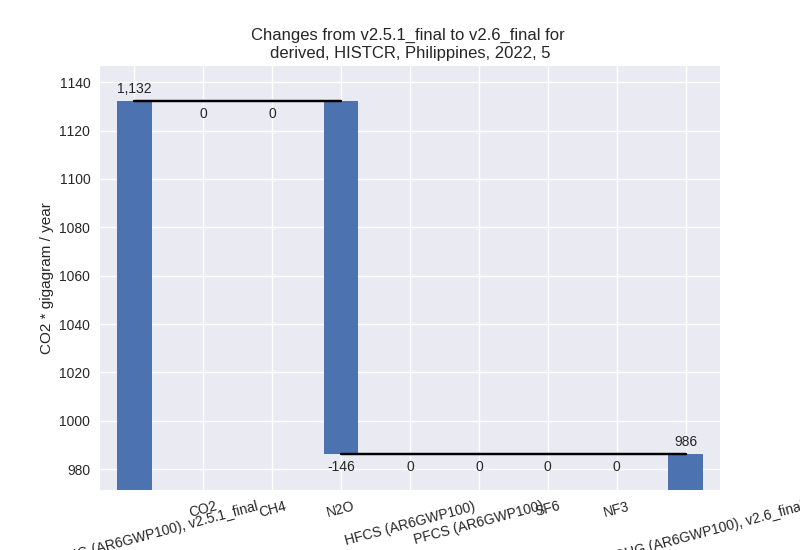
third party scenario (HISTTP):
Most important changes per time frame
For 2022 the following sector-gas combinations have the highest absolute impact on national total KyotoGHG (AR6GWP100) emissions in 2022 (top 5):
- 1: 1.A, CO2 with -4121.67 Gg CO2 / year (-2.9%)
- 2: 5, N2O with -145.85 Gg CO2 / year (-12.9%)
- 3: 4, CH4 with -130.60 Gg CO2 / year (-0.6%)
- 4: 2, HFCS (AR6GWP100) with 96.61 Gg CO2 / year (1.5%)
- 5: 4, N2O with 92.27 Gg CO2 / year (7.4%)
For 1990-2022 the following sector-gas combinations have the highest absolute impact on national total KyotoGHG (AR6GWP100) emissions in 1990-2022 (top 5):
- 1: 1.A, CO2 with -126.70 Gg CO2 / year (-0.2%)
- 2: 4, CH4 with -85.67 Gg CO2 / year (-0.5%)
- 3: 4, N2O with 17.32 Gg CO2 / year (2.0%)
- 4: 5, N2O with -5.00 Gg CO2 / year (-0.6%)
- 5: 2, HFCS (AR6GWP100) with 2.93 Gg CO2 / year (0.1%)
Changes in the main sectors for aggregate KyotoGHG (AR6GWP100) are
- 1: Total sectoral emissions in 2022 are 154002.16
Gg CO2 / year which is 57.8% of M.0.EL emissions. 2022 Emissions have
changed by -2.6% (-4121.67 Gg CO2 /
year). 1990-2022 Emissions have changed by -0.1% (-126.70 Gg CO2 / year). For 2022
the changes per gas
are:
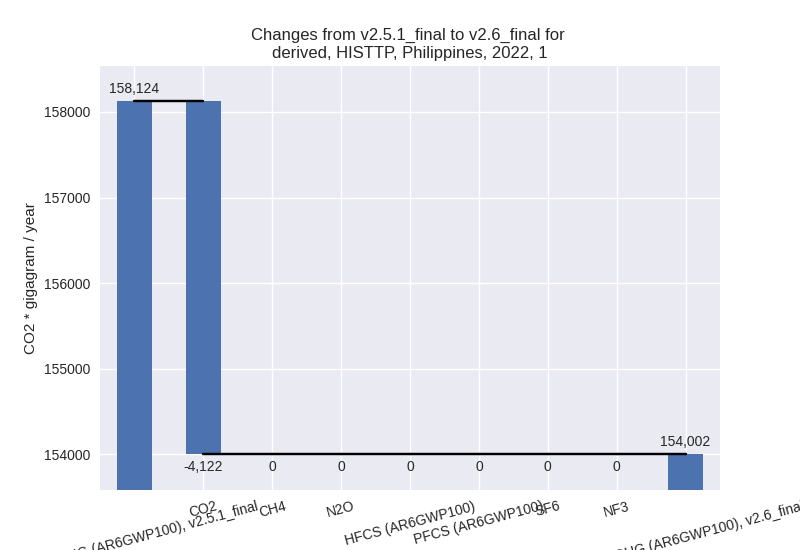
The changes come from the following subsectors:- 1.A: Total sectoral emissions in 2022 are 140892.94
Gg CO2 / year which is 91.5% of category 1 emissions. 2022 Emissions
have changed by -2.8% (-4121.67 Gg
CO2 / year). 1990-2022 Emissions have changed by -0.2% (-126.70 Gg CO2 / year). For 2022
the changes per gas
are:

There is no subsector information available in PRIMAP-hist. - 1.B.1: Total sectoral emissions in 2022 are 11615.78 Gg CO2 / year which is 7.5% of category 1 emissions. 2022 Emissions have changed by 0.0% (0.00 Gg CO2 / year). 1990-2022 Emissions have changed by 0.0% (0.00 Gg CO2 / year).
- 1.B.2: Total sectoral emissions in 2022 are 1493.44 Gg CO2 / year which is 1.0% of category 1 emissions. 2022 Emissions have changed by 0.0% (0.00 Gg CO2 / year). 1990-2022 Emissions have changed by 0.0% (0.00 Gg CO2 / year).
- 1.A: Total sectoral emissions in 2022 are 140892.94
Gg CO2 / year which is 91.5% of category 1 emissions. 2022 Emissions
have changed by -2.8% (-4121.67 Gg
CO2 / year). 1990-2022 Emissions have changed by -0.2% (-126.70 Gg CO2 / year). For 2022
the changes per gas
are:
- 2: Total sectoral emissions in 2022 are 18704.21 Gg CO2 / year which is 7.0% of M.0.EL emissions. 2022 Emissions have changed by 0.7% (123.29 Gg CO2 / year). 1990-2022 Emissions have changed by 0.2% (18.75 Gg CO2 / year).
- M.AG: Total sectoral emissions in 2022 are 68266.44 Gg CO2 / year which is 25.6% of M.0.EL emissions. 2022 Emissions have changed by 0.0% (0.00 Gg CO2 / year). 1990-2022 Emissions have changed by 0.0% (0.00 Gg CO2 / year).
- 4: Total sectoral emissions in 2022 are 24429.76 Gg CO2 / year which is 9.2% of M.0.EL emissions. 2022 Emissions have changed by -0.1% (-36.18 Gg CO2 / year). 1990-2022 Emissions have changed by -0.4% (-68.08 Gg CO2 / year).
- 5: Total sectoral emissions in 2022 are 986.22 Gg
CO2 / year which is 0.4% of M.0.EL emissions. 2022 Emissions have
changed by -12.9% (-145.85 Gg CO2 /
year). 1990-2022 Emissions have changed by -0.6% (-5.00 Gg CO2 / year). For 2022 the
changes per gas
are:
